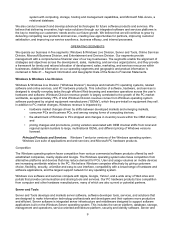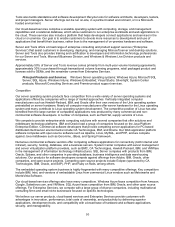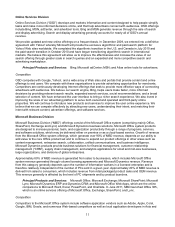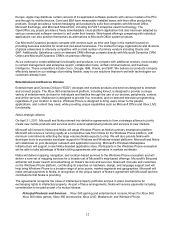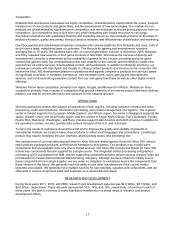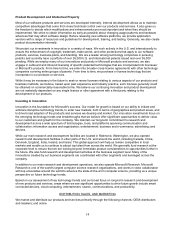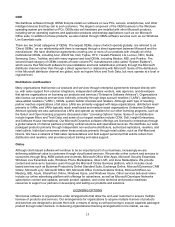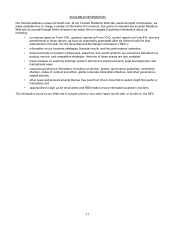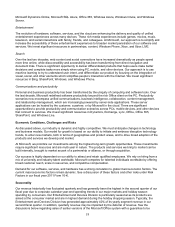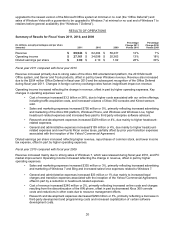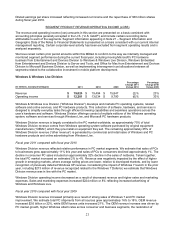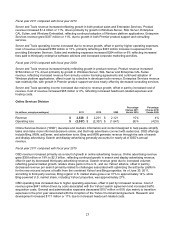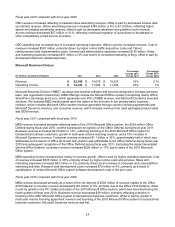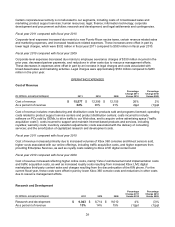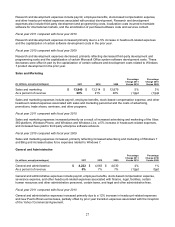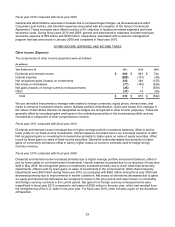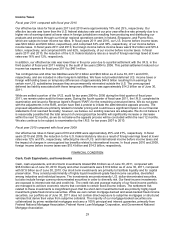Microsoft 2011 Annual Report Download - page 19
Download and view the complete annual report
Please find page 19 of the 2011 Microsoft annual report below. You can navigate through the pages in the report by either clicking on the pages listed below, or by using the keyword search tool below to find specific information within the annual report. 19
Microsoft Dynamics Online, Microsoft SQL Azure, Office 365, Windows Azure, Windows Intune, and Windows
Server.
Entertainment
The evolution of hardware, software, services, and the cloud are enhancing the delivery and quality of unified
entertainment experiences across many devices. These rich media experiences include games, movies, music,
television, and social interactions with family, friends, and colleagues. At Microsoft, our approach is to simplify and
increase the accessibility of these entertainment experiences to broaden market penetration of our software and
services. We invest significant resources in partnerships, content, Windows Phone, Xbox, and Xbox LIVE.
Search
Over the last two decades, web content and social connections have increased dramatically as people spend
more time online, while discoverability and accessibility has been transforming from direct navigation and
document links. There is significant opportunity to deliver differentiated products that helps users make better
decisions and complete tasks more simply when using PC, mobile, and other devices. Our approach is to use
machine learning to try to understand user intent, and differentiate our product by focusing on the integration of
visual, social, and other elements which simplifies people’s interaction with the Internet. We invest significant
resources in Bing, SharePoint, Windows, and Windows Phone.
Communications and productivity
Personal and business productivity has been transformed by the ubiquity of computing and software tools. Over
the last decade, Microsoft redefined software productivity beyond the rich Office client on the PC. Productivity
scenarios now encompass unified communications, business intelligence, collaboration, content management,
and relationship management, which are increasingly powered by server-side applications. These server
applications can be hosted by the customer, a partner, or by Microsoft in the cloud. There are significant
opportunities to provide productivity and communication scenarios across PCs, mobile devices, and other devices
that connect to services. We invest significant resources in Dynamics, Exchange, Lync, Office, Office 365,
SharePoint, and Windows Live.
Economic Conditions, Challenges and Risks
As discussed above, our industry is dynamic and highly competitive. We must anticipate changes in technology
and business models. Our model for growth is based on our ability to initiate and embrace disruptive technology
trends, to enter new markets, both in terms of geographies and product areas, and to drive broad adoption of the
products and services we develop and market.
At Microsoft, we prioritize our investments among the highest long-term growth opportunities. These investments
require significant resources and are multi-year in nature. The products and services we bring to market can be
built internally, brought to market as part of a partnership or alliance, or through acquisition.
Our success is highly dependent on our ability to attract and retain qualified employees. We rely on hiring from a
mix of university and industry talent worldwide. Microsoft competes for talented individuals worldwide by offering
broad customer reach, scale in resources, and competitive compensation.
Demand for our software, services, and hardware has a strong correlation to global macroeconomic factors. The
current macroeconomic factors remain dynamic. See a discussion of these factors and other risks under Risk
Factors in our fiscal year 2011 Form 10-K.
Seasonality
Our revenue historically has fluctuated quarterly and has generally been the highest in the second quarter of our
fiscal year due to corporate calendar year-end spending trends in our major markets and holiday season
spending by consumers. Our Entertainment and Devices Division is particularly seasonal as its products are
aimed at the consumer market and are in highest demand during the holiday shopping season. Typically, the
Entertainment and Devices Division has generated approximately 40% of its yearly segment revenue in our
second fiscal quarter. In addition, quarterly revenue may be impacted by the deferral of revenue. See the
discussions below regarding sales of earlier versions of the Microsoft Office system with a guarantee to be


